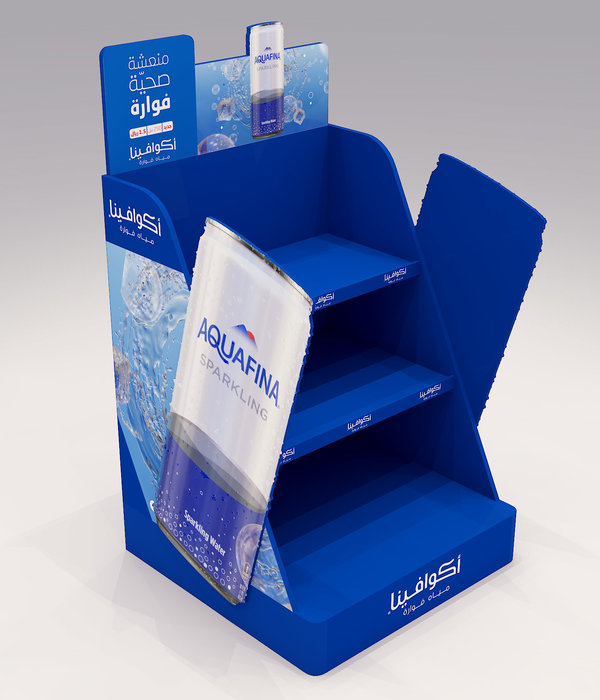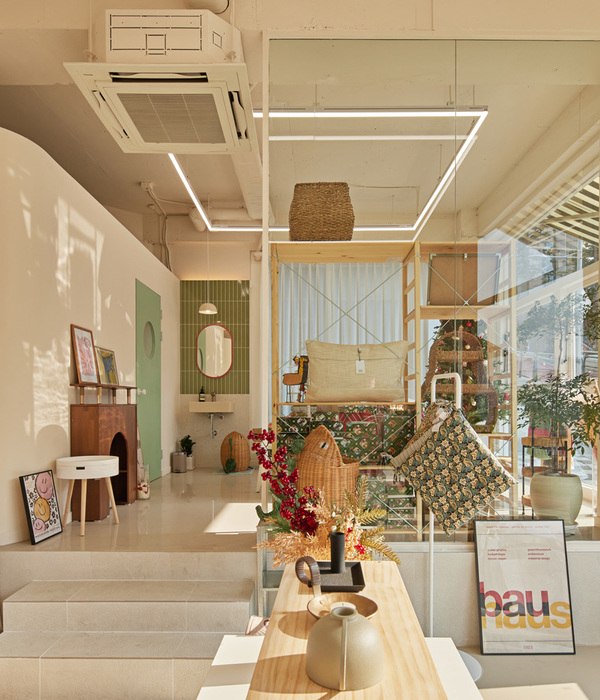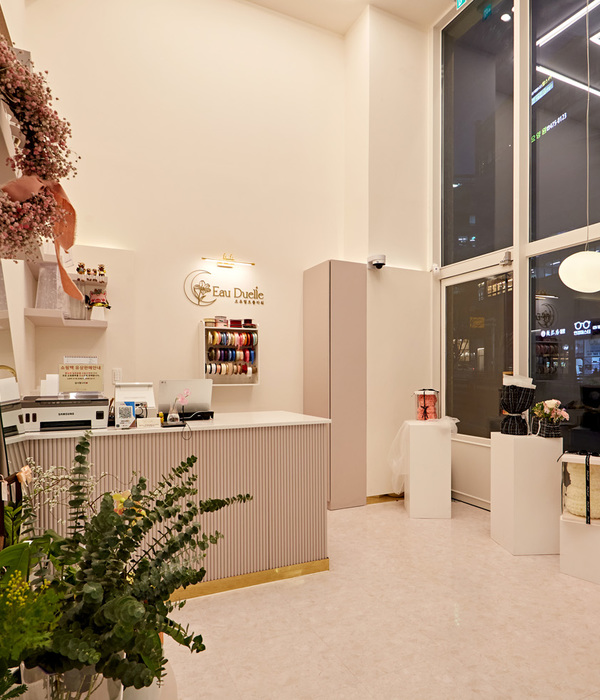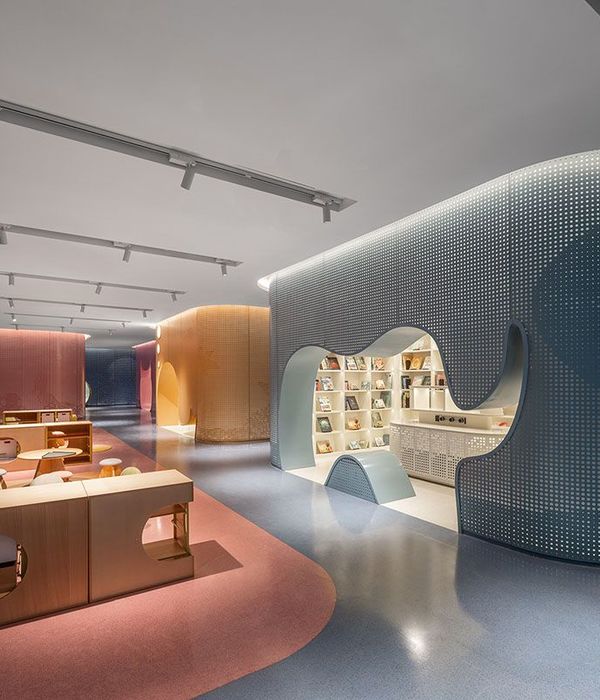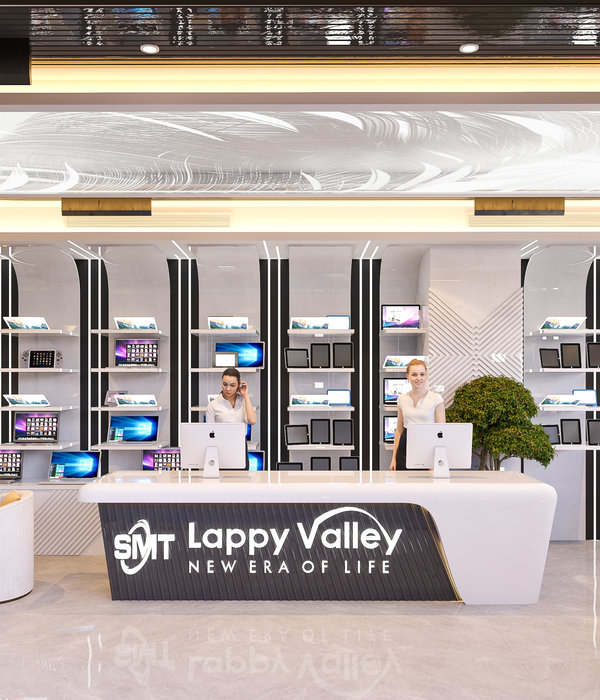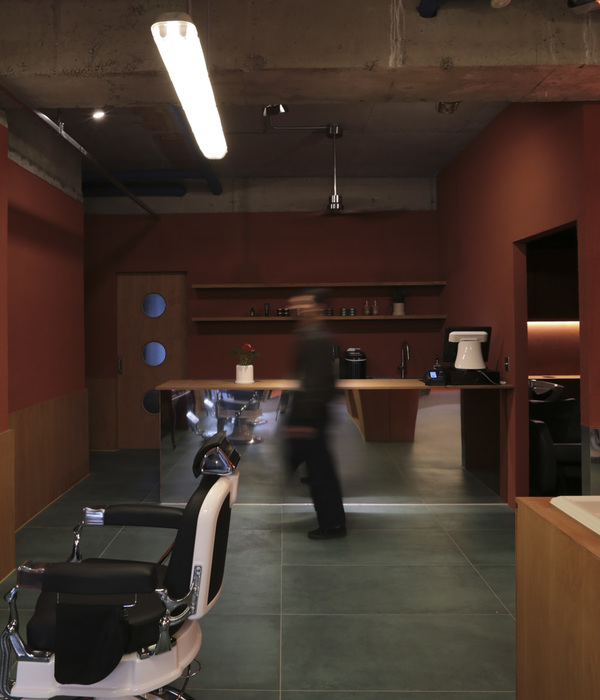在2019年的Hello Wood夏季建造节上,来自全球不同地区的20个专业工作室展示了他们非凡的临时装置作品,为以木材为主的建筑原型提供了更多创意和可能性。下面就让我们来看看今年展出的有趣作品:
At this year’s Hello Wood International Summer School and Festival, twenty workshops from across the world celebrated the event by presenting a series of amazing installation works, showing potentials of the creation of building prototypes.
共享寺庙
Communal Temple by Hello Wood
Team leaders: Péter Pozsár, Márton Pintér
Team: Nóra Fekete, Fruzsina Karig
由木制的拱梁横向排列而成,犹如一座神圣的寺庙,为Hello Wood的场地赋予了浓厚的节庆氛围。
By encapsulating the spirit of Carnival, Hello Wood’s temple is a dedication to the community of attendees that help make the event possible. It is a symbol of what can be achieved by a sense of togetherness, and of the connectedness that comes from the festival’s ‘tribe’ of architects that come together each year to conceive and build their projects. Formed of a number of wooden, arched beams, the Communal Temple acted as the farewell performance for this year’s festival in which everyone in the camp held one of the many wooden beams upright, resembling a temple and directly inspiring the sense of community at Hello Wood Festival’s core.
狂欢桌子
The Carnival Table
Team leaders: Space Saloon (Danny Wills, Gian Maria Socci), Lemonot (Sabrina Morreale, Lorenzo Perri), Zsofia Sonia Illes
Team: Igor Nesterov, Dominika Ufnal, Alice Kim, Ian Davide Bugarin, Carla Procida
一张抽象的、像披萨饼一样的桌子,表达了狂欢的心情。人们可以在以食物为主题的场景中交流想法。
The Carnival period is widely considered to be a time for feasting, which was the straightforward inspiration behind The Carnival Table. However, in much the same way that the traditional festivities are considered to be a time of transformation so too is the table itself. Designed to be individual masks used as part of the parade at the end of the festival, these abstract pizza-shaped pieces connect to form a large communal table where people can come together to share in the culture of food. The Carnival Table is at once about the individual and the collective, its creators concerned of the modern issues surrounding migration yet hoping to express a more pleasant view of the topic through each of our own varied connections with food and culture.
The Lubolos
Team leaders: Nacho Correa, Paco Hernández, Santiago Vera, Rosina Secondi, (Agustín Dieste)
Team: Nicolás Benjamín Boscoboinik, Vanja Ivkovic, Yara Samaha, Guo Changtao, Zgólay Regina
一对巨大的轮子,同时也可以当作鼓来“演奏”。灵感源于乌拉圭传统的Candombe音乐。
This Uruguayan quartet have a strong heritage of Carnival within their culture, and that has inspired their project this year. Uruguay has the longest Carnival period in the world, where music and processions play prominent roles. Candombe is unique to Uruguay, an offshoot of African drum music that was cultivated by the slaves that were once a part of Uruguayan society and has since grown to become an integral part of the country’s culture. With this at its heart, the concept of a giant drum was born, built as a mechanism that will reproduce the sound of the three drums that are a part of Candombe music. Crucially, the giant pair of wheels will be operated by two ‘drummers’ on either side of the wheel; neither can see one another though, highlighting the connectedness that comes from being a part of a community due to the need to blindly cooperate for the drum wheel to function properly.
拆箱的节日
Carnival Unboxing Day
Team leaders: Kris Drieghe
Team: Karolina Lazar, Marta Bautista Useros, Anastasia Sin’kova, Alina Rapp, MR M J MITCHELL, Cezary Adamowicz
正方形、圆形和三角形的入口引发了人们的思考:我们如何在面临巨大分歧和差异的情况下共同生活?
When the differences between us can cause so much divide, how can we ever live together? That’s the question posed by this installation, which envisions these differences as abstract shapes: a square, a circle, a triangle. Your religion may be a square, where you’re from may be a circle, what you eat may be a triangle, and you take that shape with you when you’re out in the world. For this project, the shapes are boxes that are worn as part of the Hello Wood Carnival procession, but the only way to access the coordinating structure is to enter through their respective gateways: a square through the square entryway, a circle through a circle, and so on. Once inside the structure, these costumes can be shed – unboxed, even – representing the idea that we can only truly live together if we overlook the differences between us.
Ludus
Team leaders: Silvia Lacatena, Fabrizio Rosanova, Alessio De Galizio, Stefano Battaglini, Giulia Beretta, Marino Amodio
Team: Jiří Valenta, Geraldine Reid, Sara Abekova, Julia Panasiuk, Anton Schwingen
Ludas是一个充满游戏趣味的纪念碑,多层次的结构中装置着一系列秋千和跷跷板,使人回忆起儿时在操场上玩耍的自由感觉。
From the get-go, Ludas was conceived as a monument to play, which has gone on to filter down through into every aspect of the project. This multi-tiered structure is bright and colourful, filled with swings and seesaws that recall our younger days on the playground when we felt a sense of freedom. The seesaw, in particular, is a symbol of that freedom, since as a game it has no goal or score; nor does it need effort and produces nothing, it is play for the sake of play. There’s an intentional contrast between the lightness of this sort of game and the scale of Ludas, a towering structure that sits amid the many cabins of the area acting as a sort of town square for the Hello Wood community, decorated with all of the things that remind the team members of their own childhoods.
建筑自治宣言
Manifesto of Architectural Autonomy
Team leaders: Agnieszka Roś, Szabolcs Egyed
Team: Kristýna Mocová, Dan Innes, Matthew Dodd, SHIH MINYU, Daria Kristal
一座可以充当瞭望台的高塔,它包含了所有建筑都必须拥有的基本元素:门、窗、屋顶和楼梯,从某种程度上象征着建筑师在工作中不可避免地需要借助这些最基本的要素来对建筑行使“自主权”。
Architects often have grand visions to change the world through their creations, but at its core there are always the same elements at their disposal. Inspired by Hello Wood’s manifesto for the Builder Society and its drive to do something more for society, this structure is a tower dedicated to the different elements that every piece of architecture must have: a door, windows, a roof, stairs. Hanging on this tower – which also acts as an observation tower – are representations of each of these components, representing a sort of unavoidable autonomy that architects must deal with by the very nature of their work. These facets are the foundation of every structure, and that is an architect’s manifesto.
摩天轮
Ferris Wheel
Team leaders: Neal Lucas Hitch, Martin Hitch
Team: Charlotte Buannec, Jakub Drzastwa, Matteo Fontana, Jessica Lai, Tereza Šírerová
狂欢节怎么可以缺少摩天轮?这座巨大的摩天轮被称作“Hello Wood之眼”,缤纷的色彩吸引着人们的注意,传达着“一切皆连通”的信念。
No carnival is complete without a ferris wheel, and that was the foundational idea behind this spinning sight visible from the entrance to Hello Wood’s Summer School and Festival camp. Deemed to be the ‘Eye of Hello Wood’, it references the famous attraction of London and aims to offer the same iconic ability to draw your attention from a distance, and is designed to be colourful and eye-catching like any tourist attraction should be. But there’s a deeper symbolism to this project, too, with the ferris wheel representing a Venn diagram with only one circle, the belief that everything is connected and the same. It’s a message of community and connectedness, one that suggests that no one is different from another person at all – that we are all part of the same organism.
派对神庙
Party Temple
Team leaders: Martial Marquet, Vojtech Nemec
Team: Nikolaj Srdić Kranjc, Jemima Brakspear, Hamid Aghashahi, Winson Yeung, Karolina Krzyżanowska
由八个三角形模块构成的聚会地点,其形式参考了南美热带雨林深处的亚诺玛米部落居住的圆形建筑。
Deep in the rainforests of South America live the Yanomami, an isolated community of tribes native to the land who live in circular, communal structures. The centre of these buildings are used for rituals and events, and this project aims to replicate that. The difference, however, is that with the theme of Carnival at its heart, this set of eight triangular modules is devoted not to shamanism – as with the Yanomami – but a rather more modern religion: the cult of partying. By using these modules, a central space is enclosed as a gathering point for all fellow worshippers to party the night away. Each of the modules, which resemble an architect’s set square, are used for specific purposes, whether for the DJ, spaces to dance and shout, or others to chill and shelter from the sun. It is a modern temple, and one fit for Carnival.
WeMask
Team leaders: Natalia Vera Vigaray, Patxi Martin, Josep Garriga Tarres, Alžběta Brůhová, Tina Peirlinck
Team: Leva Davulyte, Lucie Blanchot , Charnjeev Kang, Daniel Menšík
WeMask是一个与行为有关的结构,它必须在多人的协作下才能发挥作用:参与者必须共同决定结构摆放的位置、由谁来充当墙壁,又由谁来扮演内部的狂欢者。
A combination of two teams with shared ideals, WeMask is a performative structure that relies on its participants to achieve its vision of collectiveness, who will hold up the straw roof. Only then does the cone become a structure, a representation of how a community must work together to achieve its goals since it cannot function without even one of its human ‘walls’. It is only by making decisions together as a collective that WeMask can work: where to place the structure, who must be a wall and who can be a reveller inside the shelter, or even which outsiders are allowed in. But on top of its strong message, the team behind the project is also devoted to sustainable construction, with the roof constructed solely of materials gathered on-site and without the use of any electrical tools.
Pacha K’anchai
Team leaders: Angelo Ferrara, Viviana Schimmenti, Santiago Ruiz Lavaselli, Camille Larroque, Nelson Larroque
Team: Botond Kende Gazda, Lauren Fashokun, Nina Hofmann, Will Hayter, Abigail Hinchley
Pacha K’anchai来源于印加盖丘亚语,意思是来自太阳的光:一种充满能量与生命的自然元素。用黏土覆盖的木制结构内部燃烧着一小簇篝火,成为一处祭坛般的存在。
‘The light from the sun: a universal element, plenty of energy and life,’ that is Pacha K’anchai. The meaning comes from the Inca Quechua language and draws out the closeness that this pagan altar to fire has with the element. A wooden structure was clad in clay and heated with a small fire inside, drying the material to make a hardened furnace – a dedication to the power, romance and life-giving capabilities of fire. In much the same way that tribesmen might in their own rituals, the performative aspect of Pacha K’anchai had its ‘shamanic’ creator of the fire pass the flame that was used to burn the wooden interior on to its participants, representing the same significance that humankind once placed on the possession of fire.
旗-舰
Flag-Ship
Team leaders: Sabrah Islam, Sung Yeop Lim, Sonya Falkovskaia
Team: Michael Tsang, Petró Panni, Leyla Hepsaydir, Tomáš Čunderlík
船形的结构在远离主展场的地方俯瞰着向日葵田,代表着不同区域的旗帜为节日中的人们创造出风景和凉爽的感受。
Where many of the festival’s installations this year are bombastic, taking on both literal and metaphysical ideals of celebration, Flag-Ship is rather more serene in its attitude towards the concept. Concealed away from the main camp overlooking a field of sunflowers, the ship-shaped structure celebrates a global community. The decision for a direct connection with the landscape was intentional, allowing for a more relaxed location away from the noise of electrical circular saws and Hello Wood festivities and instead surrounded by the flapping of world flags – which coincidentally create shading for those who want to enjoy the view.
冰淇淋推车
Ice Cream Truck
Team leaders: Suzana Milinović, Rufus van den Ban
Team: Shanice Abbey, Filip Cerha, Johanna Richter, Marta Irma Zabik, Casper Hylkema
在匈牙利的炎热夏季,一辆冰淇淋车显然必不可少。它代表着一种现代的享乐,代表着“纯粹为了享受而非填饱肚子”的进食。
This year, the repeated demands for ice cream from this part of Hello Wood veterans was going to go unheard no more. If there won’t be ice cream to survive the baking heat of Hungarian summers, then they would simply have to provide the ice cream themselves. But there’s a deeper meaning to the installation, one that leverages Carnival’s notorious time for feasting at its centre. Ice cream is not a nourishing food, but one eaten purely for its enjoyment; it is modern feasting, eating for the enjoyment of it rather than the need. In translating this concept to architecture, however, the ice cream truck is representative of the underlying theme of the project: ornament. Much like a feast of cold treats, ornamental design is not done so with purpose but instead with glorification, the human touch and form over functionality at its core. The fact that the truck can dole out ice cream to on-lookers and participants of the parade is just a fun extra for those with a sweet tooth.
Mjölk
Team leaders: Jan Vondrák, Jan Mach, Pavlína Müllerova
Team: John Cummins, Evdoxia Golobia, Valentin Warminski, Sofija Mašović, Brigita Teplanova
Mjölk是一个由树枝编成的框架,所有的材料都是从现场收集而来。它忽略了建筑的技术细节,将人们的注意力引向物质和实体本身。
Across centuries, Carnival has often been about masking oneself, hiding behind an unknown identity to make all equal. This is a communal mask, a wooden scaled creature that its team can lift up from the inside and carry as part of its parade. That in itself creates a close, intimate connection, the sort that would once be necessary for smaller communities to survive. But this worm-like beast was built with greater goals in mind, eschewing the modern architectural demands of straight lines, cross sections and precise measurements. Instead, it is built with a frame of branches and sticks found on site, ignoring the technical details of construction in favour of something more tangible and physical. With no plans beyond a concept, this wooden snake was as much about the creative process of building as it was the final project.
成为动物
Becoming Animal
Team leaders: Julia Wildeis, Christian Daschek
Team: Nefin Erkul, Chongyuan Duan, Dorottya Kiss, Fanni Csöbi, Jakub Sampławski
这是一套实用的家具,可以被人们随意地拆解和穿戴,并随之获得动物般的习性。
What does it mean to transform, and how can architecture and design enable that? With the transformative concepts of Carnival at its heart, Becoming Animal is a set of functional furniture that can be deconstructed and worn by the team as part of the Hello Wood Festival parade. While these pieces might not resemble any given creature, they are still able to empower its wearer with the essence of that animal; one may not look like a gorilla while wearing the legs of a stool, but it’s possible to move like one, act like one, relax like one. In this sense these costumes can become living entities, much like how Carnival is about adopting a different role.
奔跑的时间
Running Time
Team leaders: Pavol Šiška, Peter Sálus
Team: Chris Myk, Emily Cronin, Yi-Chieh Chen, Dorothy Zhang
“时间不等人”,这就是装置所要呈现的信息。即使你保持不动,也无法摆脱时间的流逝。时间一直在奔跑,却不是为了我们。
‘Tide and time wait for no man,’ it is said, and that’s a message that this installation seeks to present. Time is one of those fickle enemies that so many of us feel we have to constantly battle against: there just isn’t enough time in the day, we might think. But Running Time presents a counter offer. It suggests that even if you’re stationary you can’t escape the wheel of time, hence the creators of this installation think it’s better to relax, to avoid rushing for things and being in a hurry for everything to change, improve or succeed. Time is running, but not for us.
告解室
Confessional
Team leaders: Lee Ivett, Susie Olczak
Team: Melissa Kosseifi, Enzo Miot, Marta Esteban, Huang Chih-Yian, Janka Dócs
这是一个可以用来分享秘密和寻求慰藉的私密空间,可以同时容纳两个人。狂欢的节日里,罪恶、欲望和愧疚的情绪也可能达到高点,这就为告解室的存在赋予了必要性。
In wanting to build a space that allowed for the kind of privacy capable of sharing intimacy and finding solace, the Confessional is built as a pair of sedan chairs that can be carried individually but can come together to form a single unit. In this it allows for two people to be open, to share the sort of personal details that are much more than the noise we shout into digital world of social media. But in that there is a responsibility to listen, too, and more importantly not to judge. And at a Carnival, where the potential for sin, lust and guilt is likely to be at its highest, perhaps a place to confess is a necessity.
出卖色相的建筑师
The Architect as a Prostitute
Team leaders: Keimpke Zigterman, Veerle Rigter
Team: Paul BOURNE-MADELENAT, Miryam Yakub Aga, Aisha Nadim , Abdul Saleem
这组装置的中心思想是:建筑师需要像出卖色相者一般,向客户进行自我推销。他们不光出售自己的技能,也出售自己的想法、个性甚至是灵魂。
Over a set of three different installations, this performative trio represent the central idea that – much like a prostitute – an architect must sell themselves to their clients. More than that, in fact, such professionals must also sell their ideas, their personalities and even their souls. The first of the installations is a glass case not unlike the windows of a red light district, referencing the need for an architect to showcase themselves to the world in order to make a living. The second is a billboard, a place for announcements of events and workshops that were taking place during the week-long festival at Hello Wood. Lastly is the chair of judgement, inspired by the need to judge and the desire to be judged through social media platforms – a like or a retweet akin to the currency of a successful architect.
Brugga
Team leaders: Tatiana M. Melo, Maria Roy
Team: Timothy Betton, Christoph Elmecker, Xueying Wang, Frida Navratil, Gerda Antal
该装置设想了一个人类已经移居到火星的时代,它是一个能够在荒地中存活的结构,顶部的水箱和覆盖在外部的植物使其能够自给自足。同时,Brugga女巫的仪式将为其赋予特殊的能量。
By envisioning a time where the Earth is no longer fertile and humankind has moved to Mars, the team behind Brugga wanted to create a structure that could survive the wastelands. This multi-tiered tower is powered by the rituals of the Brugga witches – born from the Spanish word bruja for witch – intended as a means of rejuvenating the land. Covered in plants and replete with a water tank at the top, the tower can allow for self-sufficiency within a desolate land. But it’s also symbolic of much more, too, with individual sections dividing the structure, from the darker ‘cavern’ at the base that is surrounded by natural elements and where the witches will practice their rituals up to the top floor with a craft table.
照相馆万神庙
Photo Booth Pantheon
Team leaders: Lilla Árkovics, Bernadett Csendes, Attila Róbert Csóka, Dávid Smiló, Szabolcs Molnár
Team: Juan Agustin, Alžběta Hejnová, Esther Calinawan, Gerrylyn Saraza, Flynn Williams
每个地方都需要一个能够铭记英雄与神灵的地方。万神庙中展示着历届工作坊团队领导者的照片,为游客展示了有关Hello Wood建造营的历史。
Hello Wood’s manifesto for the Builder Society and its desire to do good for the world inspired this pantheon, whose shape is based on the famous Roman landmark. Every society needs a place to remember their heroes and their gods, but countless statues of past workshop leaders is not possible at the Hello Wood camp. This is why this particular Pantheon is also a photo booth, a place dedicated to showcasing the visitors of the past and a monument to the ten years of Hello Wood’s Summer School and Festival.
超越
Beyond
Team leaders: Joan Lluc Piña, Quim Escoda Llorens , Carmen Bodelón
Team: Matthew Pembery, Maria Antonia Rigo Serra, Juliet Welshman, Mohammad Abbasi, Karolina Kowara
在节日结束之后会发生什么?这座可移动的小屋可以被用到生活的方方面面:聚会、吃饭或者睡觉。狂欢之后是一切与日常有关的事。
What happens after the Hello Wood festival? What is beyond the event and its creations? These are the considerations that power Beyond, a set of moveable cabins that its creators hope they can recycle for a cooperative housing project that they are working on back in the neighbourhood of Sant Muç. But they’ve got to make it back there, and that’s the intention: this set of cabins are small enough to be dedicated to each aspect of life, carnival, and beyond. There is a space dedicated to partying, one to eating, another to sleeping; everything that is necessary for life, Carnival and Beyond.
{{item.text_origin}}


